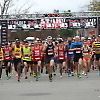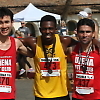UjENA FIT Club 100 Interesting Running Articles
Best Road Races and the UjENA FIT Club is publishing 100 articles about races, training, diet, shoes and coaching. If you would like to contribute to this feature, send an email to Bob Anderson at bob@ujena.com . We are looking for cutting edge material.
Click here to read all Running Articles
Posted Wednesday, February 11th, 2015
By David Prokop Pleasanton, Calif., may be a quiet, relaxed community across the bay from San Francisco, but where Double... Read Article
Posted Monday, September 15th, 2014
Peter Mullin has taken Double Racing® by storm. He broke the 60-64 age group world record in the first Double... Read Article
Posted Monday, September 22nd, 2014
by David Prokop (Editor Best Road Races) Photo: Double 15k top three Double Racing® is a new sport for... Read Article
Posted Sunday, May 11th, 2014
By David Prokop, editor Best Road Races The world’s most unusual race met the world’s most beautiful place, in the... Read Article
THE DOUBLE - Race Strategy Part 3
Friday, November 9th, 2012
A ROAD RUNNER’S CHESS MATCH
by Dave Prokop After reading The Double – A Runner’s Chess Match, famed marathoner Bill Rodgers, who will participate in the Pleasanton Double Road Race™ Dec. 23, sent us an approving e-mail which said, in part, “Folks will enjoy this race more when they consider it a strategy event … with different options available to all runners.” We looked at 20 of those options in Parts One and Two. This week, in Part Three, we’ll look at 10 more. This will be followed by still another 10 next week in Part Four. If you’re running the Double, consider all the possible strategy options and make your choice. For that matter, perhaps you have a strategy of your own creation you’ll want to use. Heaven knows, we don’t have the cornerstone on creativity when it comes to strategy possibilities in the Double. What we’re simply trying to do is provide you with as many strategy variations as possible for a competition that is new and unfamiliar to almost everyone who will be running in it, since this will be the first time the Double is held on U.S. soil. 21. THE SHOOTING-FOR-YOUR-PERSONAL-BEST STRATEGY -- Forget about the runners around you and just orient yourself, starting with your training and then in the competition itself, to running the best aggregate time you can. Each time you run the Double, try to set a new personal best aggregate time. 22. THE NEGATIVE-Split-SQUARED STRATEGY -- Run the 10K in a negative split fashion (second half faster than the first half), then run the 5K the same way. Plus, run closer to your maximum effort in the 5K than you did in the initial 10K, another type of negative split. Thus the Negative-Split-Squared Strategy. 23. THE ARTHUR LYDIARD STRATEGY -- The great New Zealand distance coach Arthur Lydiard used to have his athletes do trial runs over three quarters of their racing distance at race pace as a sort of dress rehearsal, i.e., to get their bodies used to what they were going to experience in the race itself. It also served as a guide to where the athlete was in his conditioning. This could be a valuable strategy to apply to the Double. For instance, a week or two before the Double, run a hard four miles, take a comparable rest break to the one you're going to get in the Double, then run a hard two miles. See how you handle that, and use the experience to guide you when you run the Double itself. Comments and Feedback
|
,,,,, |
24. THE TRAINING SESSION STRATEGY -- Use the Double as a training session, a kind of step-down interval workout consisting of a 10K and a 5K, with approximately an hour's rest in between. No one would disagree that from a training standpoint, this is a demanding workout. One which would enhance your conditioning, your mental toughness and your awareness of your capabilities and limitations. Say you're a college distance runner who will be required to double in dual meets, e.g., running the 1500 and the 5000. Wouldn't the Double be an excellent training workout to prepare from a stamina point of view for that sort of competitive challenge? Putting it another way, after you've done the 10K and the 5K of the Double, how difficult will the 1500 and 5000 double seem? 25. THE GROUP STRATEGY -- Make the Double a group effort, either with family, friends, teammates, etc., everybody running together to ensure the slower runners are paced through by the faster runners. 26. THE WAITING-TO-ATTACK STRATEGY -- Run conservatively at the beginning, then be mentally and physically ready to be at your best in the 5K if you think that's where the competition will be decided, even in terms of aggregate time. 27. THE I'M-HERE-TO-SUPPORT STRATEGY -- Run in a supportive fashion with your spouse, girlfriend, family member, etc., to ensure the best possible running experience, or if you're a track coach (high school, college, track club), to help and encourage your athletes throughout the competition. 28. THE RUN-AS-I-FEEL STRATEGY -- Forget about time. Go by feel or level of effort. During his heyday, the phenomenal Australian 5- and 10,000-meter runner Ron Clarke, he of the multiple world records, was said to listen for the time only at the end of the first lap of his track races to give him an idea of his speed. From then on he just pushed the pace at the max of his ability to maintain it for the entire distance. He didn't pay much attention to the stopwatch, he just ran as he felt. Of course, being as good as he was, running as he felt produced world records galore. 29. THE HERE'S-LOOKING-AT-YOU-KID STRATEGY -- In the movie classic, Casablanca, Humphrey Bogart uttered those unforgettable words to Ingrid Bergman, "Here's looking at you, kid." This is the slogan many elite runners in the Double need to keep in mind. Why? Imagine you're an ace runner settled comfortably in the lead pack during the 10K of the Double. You know the kind of pace and time you want to run, and you're good enough and hope to win. But in the Double you need to stay vigilant at all times and keep your eyes on your rivals -- the "Here's looking at you, kid" strategy. Because while you're striding towards the finish line of the 10K, looking forward to the rest break and the 5K, which you're thinking will decide the competition, someone could unexpectedly jump the field and get a 30-second lead in the closing stages of the 10K. Then where are you? So in the Double particularly, if you're good enough and hope to win, keep your wits about you at all times and watch your main rivals lest someone tries to "steal" the race. 30. THE ALWAYS-GO-FOR-THE-GUTSY-MOVE STRATEGY -- This is the other side of the coin to the example given above. If you can imagine yourself being the runner who was victimized by the athlete who suddenly jumped the field and got a big lead when you weren't paying attention, you also can imagine yourself as that other person who had the initiative and guts to make that move. In a tactically oriented competition like the Double, willing to make the gutsy move can pay big dividends, as in the example cited above. |

Copyright 2025 UjENA Swimwear · Site Map · Feedback · Tell A Friend · Nominate a Race
Leaderboard · UjENA 5K · Double Road Race · UjENA Jam · UjENA Network














 Photo: four time New York and Boston Marathon winner Bill Rodgers is hoping to break 70 minutes. His team of three will be competing in the Invitational Age-Graded team division.
Photo: four time New York and Boston Marathon winner Bill Rodgers is hoping to break 70 minutes. His team of three will be competing in the Invitational Age-Graded team division. 
